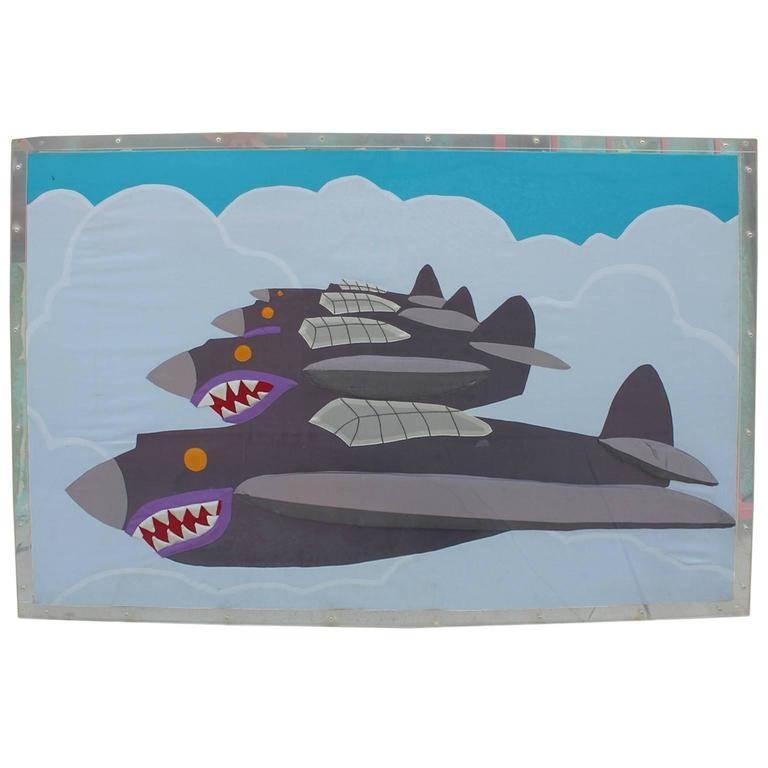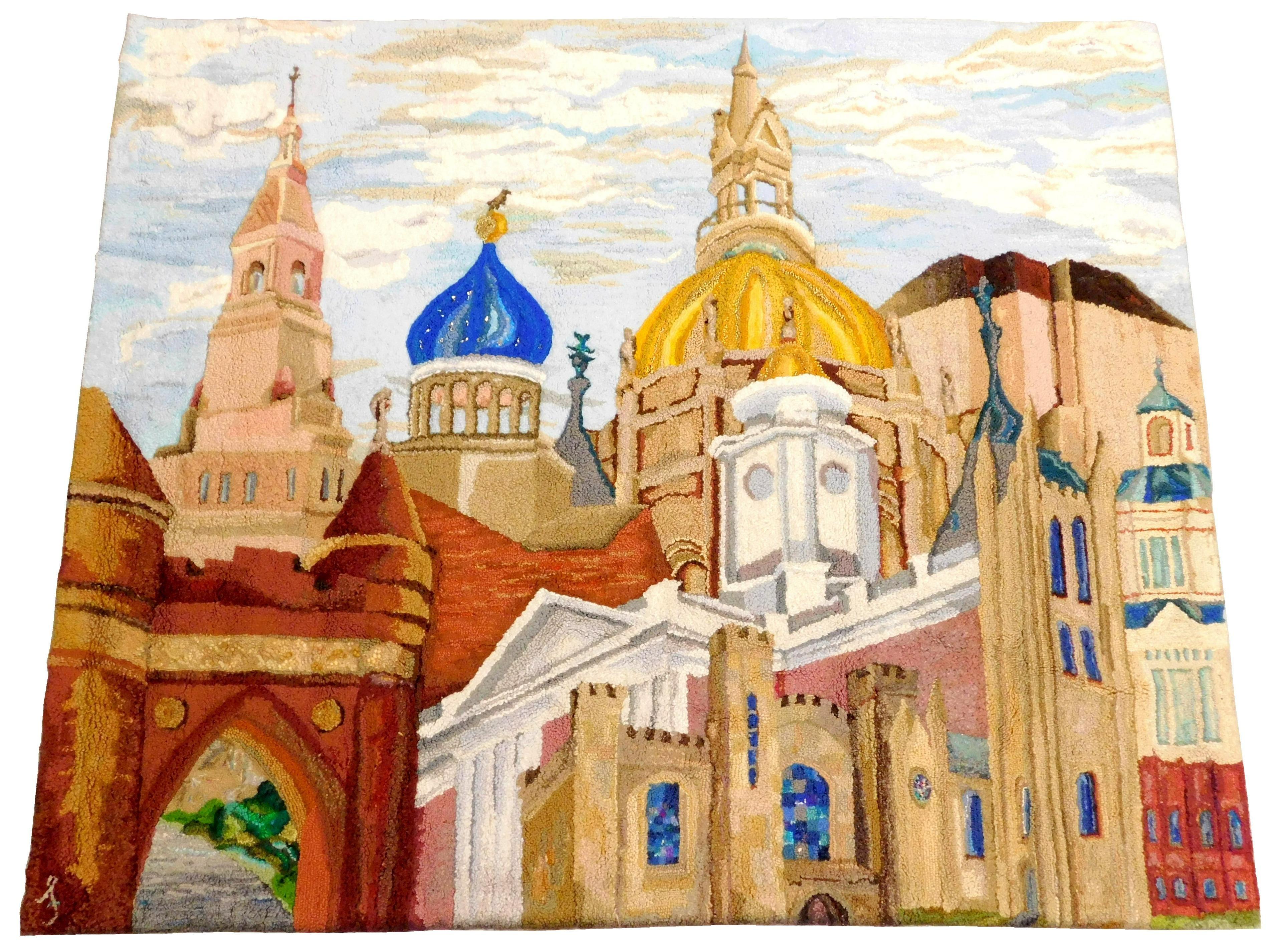Items Similar to Forbidden Stitch Embroidery of A Chinese Vase
Want more images or videos?
Request additional images or videos from the seller
1 of 5
UnknownForbidden Stitch Embroidery of A Chinese VaseContemporary
Contemporary
About the Item
A wonderful example of Chinese embroidery, this framed silk textile uses the infamous forbidden stitch to depict a fine blue-and-white porcelain vase. Also known as the "Peking knot" or "seed stitch," the forbidden knot is a silk embroidery method that results in minuscule, pearl-like knots, usually densely clustered to cover a fabric with color.
The vase pictured on this textile is a classic form known as 'tianqiuping' or 'celestial ball vase,' defined by its rounded, globular body and a narrow cylindrical neck. The intricately stitched blue-and-white decoration features a sinuous, celestial dragon and an all-over pattern of chrysanthemums and trailing vines.
- Creation Year:Contemporary
- Dimensions:Height: 0.5 in (1.27 cm)Width: 12.25 in (31.12 cm)Depth: 16.25 in (41.28 cm)
- Medium:
- Movement & Style:
- Period:
- Condition:
- Gallery Location:Chicago, IL
- Reference Number:
About the Seller
5.0
Diamond Seller
These expertly vetted sellers are 1stDibs' most experienced sellers and are rated highest by our customers.
1stDibs seller since 2018
26 sales on 1stDibs
- ShippingRetrieving quote...Ships From: Chicago, IL
- Return PolicyA return for this item may be initiated within 2 days of delivery.
More From This SellerView All
- Korean Hanging Scroll of Bamboo, Prunus, and OrchidsLocated in Chicago, ILThis Korean hanging scroll from the mid-20th century honors traditional calligraphy painting with delicate detail and a refined composition, thought to inspire clear and concise thin...Category
Mid-20th Century Folk Art Landscape Drawings and Watercolors
MaterialsSilk, Paper, Ink
- Japanese Meiji Hanging Scroll of Ayu Fish, c. 1850Located in Chicago, ILAlthough Western painting was initially embraced during Japan’s Meiji period (1868–1912), artists brought on a revival of traditional painting styles as they sought to create a moder...Category
Mid-19th Century Folk Art Landscape Drawings and Watercolors
MaterialsPaper, Ink, Silk
- Framed Hmong Appliqué Textile FragmentLocated in Chicago, ILDating to the mid-20th century, this colorful Hmong textile is a classic example of the appliqué technique used for the traditional cloth known as paj n...Category
Mid-20th Century Folk Art More Art
MaterialsTextile
- "Denkbilder, " Mixed-Media Sculpture, 2021Located in Chicago, ILTo Chicago-based artist Patrick Fitzgerald, his miniature car sculptures are a means of traveling through time. Born from a fascination with the soap box derby cars of his youth, eac...Category
21st Century and Contemporary Outsider Art Mixed Media
MaterialsOil, Acrylic, Cardboard, Canvas, Mixed Media
- "Maquette Car, " Mixed-Media SculptureLocated in Chicago, ILTo Chicago-based artist Patrick Fitzgerald, his miniature car sculptures are a means of traveling through time. Born from a fascination with the soap box...Category
21st Century and Contemporary Outsider Art Figurative Sculptures
MaterialsFabric, Wood, Paper, Mixed Media, Oil, Acrylic
- "Neapolitan Car, " Mixed-Media SculptureLocated in Chicago, ILTo Chicago-based artist Patrick Fitzgerald, his miniature car sculptures are a means of traveling through time. Born from a fascination with the soap box...Category
21st Century and Contemporary Outsider Art Figurative Sculptures
MaterialsWood, Fabric, Paper, Mixed Media, Oil, Acrylic
You May Also Like
- Tapete Miniatura Azul y Vino / Textiles Mexican Folk Art Miniature Rug FrameBy Eustacia Antonio MendozaLocated in Jesus del Monte, MXFREE SHIPPING TO WORLDWIDE! Artisan: Eustacia Antonio Mendoza MASTERPIECE: Miniature rug made with Silk and Cotton threads dyeing with anilines, broca...Category
2010s Folk Art More Art
MaterialsTextile, Cotton, Silk
- Abstracted Silk Applique Modern Tapestry in Lucite Frame Flying Tiger JetsLocated in Houston, TXWonderful abstract tapestry constructed of silk applique from the 1970's. Tapestry has the daring shark/airplane motif of the flying tigers. Excellent an...Category
1970s Folk Art More Art
MaterialsSilk
- Large Americana Folk Art Pictorial Hooked Rug Wool Wall Hanging TapestryBy Trudi ShippenbergLocated in Surfside, FL"Downtown Hartford" Hooked rug tapestry, various landmark buildings in Hartford, Connecticut, congregate within composition, including capital building, Colt building, Wadsworth Mus...Category
20th Century Folk Art Mixed Media
MaterialsFabric, Wool
- Large Americana Folk Art Pictorial Hooked Rug Wool Wall Hanging TapestryBy Trudi ShippenbergLocated in Surfside, FL"RFD Courant", hooked rug tapestry, rural community with country homes and buildings throughout rolling hills, lush green trees with three-dimensional leaves frame the scene, in the...Category
20th Century Folk Art Mixed Media
MaterialsFabric, Wool
- Un Dau Tri, Contemporary QuiltBy Bethan AshLocated in Brecon, PowysTriptych of three interacting panels inspired by artist's love of Graffiti as an art form and her interest in the decline and revival of the Welsh language. It is a little-known fact...Category
2010s Folk Art Mixed Media
MaterialsFabric
- Wool Felt Craft Applique Vintage Israeli Judaica Folk Art Tapestry Kopel GurwinBy Kopel GurwinLocated in Surfside, FLThis depicts King David playing the harp, along with a verse in Hebrew from the Psalms. all made by hand. woven and stitched. Vintage, original piece. Kopel Gurwin (Hebrew: קופל גורבין) (1923–1990) was an Israeli tapestry wall hanging, painter and graphic artist. Kopel (Kopke') Gurwin (Gurwitz) was born and raised in Vilna, the capital of Lithuania. He spoke Yiddish at home, but simultaneously studied Hebrew at their school which was part of the Tarbut educational network. Kopel was active in the Hashomer Hatzair youth movement. In the 1930s, as a teenager, Kopel helped his parents with the home finances by working in a suit workshop, there he first encountered the art of sewing. With the outbreak of the Second World War and the German invasion of Vilna, the Jews were imprisoned in camps and ghettos. Kopel and his brother Moshe were separated from their parents and were put to work in coal mines and peat. Kopel's parents were taken to the Stutthof Nazi concentration camp where they died of typhus within a month of each other. Kopel's 12-year-old sister Chava was turned over to the Germans by a Polish family and murdered. The brothers were arrested by the Germans, but were saved thanks to the connections of Nina Gerstein, Kopel's drama teacher. They hid in an attic until they were discovered, fled and moved to Riga, where they were caught and sent to the Stutthof concentration camp where they were imprisoned until the end of the war. They were put to work maintaining and cleaning trains and took part in one of the death marches. In July 1946, Kopel and Moshe sailed to Helsingborg, Sweden, as part of operation "Folke Bernadotte", in which Sweden took in ill survivors for rehabilitation. Once he recovered, Kopel worked in a publishing house and later was appointed director of the local branch of the Halutz movement. In 1950 Kopel and Moshe made aliyah to Israel. Kopel worked as a survey for the Survey of Israel Company. In 1951, he enlisted to the Communication Corps and served as a military draftsman. There he won first prize for the design of the front cover of the Communication Corps bulletin. With his discharge from the army at 29 he started studying drawing and graphics at the Bezalel Academy of Arts and Design in Jerusalem. Among his teachers were Isidor Ascheim, Shlomo Vitkin, Yossi Stern and Jacob Steinhardt. At the end of his first year of study, Kopel won the Reuben and Sarah Lif Excellence Award in written studies. During his studies he also won additional prizes: In 1956 he won first prize from the Lethem Foundation in California for poster design. Later the same year, Kopel won the Hermann Struck prize for his drawing on the theme of Jerusalem. In 1957 he won an additional first prize from the Lethem Foundation and second place from the printing company Ortzel for a drawing for a Jewish New Year greeting card. In 1958 he won first prize in a competition to design a poster for Tel Aviv's jubilee. Two years later he won three other awards: First and third prize for designing a poster for Israel Independence Day, celebrating 12 years of the State of Israel. Also that year Kopel won first prize for a poster to mark the 25th Zionist Congress. In 1964 he entered the Independence Day poster competition on the theme of aliyah and won first and second prize. Four years later he again entered the competition on the theme of 20 years of Israel's independence and won first prize. The poster was styled like a Holy Ark curtain with two lions and a menorah at its centre. This poster appeared on the cover of the famous book Jewish Art and Civilization, edited by Geoffrey Wigoder as well as the record Voices of 20 Years, 1948-1968, edited by Yossi Godard. In April 1971 he won first prize in the Independence Day poster competition for the fourth time. Kopel's Folk Art tapestry won the Israeli Independence Day Poster Contest in 1968 With the completion of his studies at Bezalel Kopel moved to Tel Aviv and was hired by Shmuel Grundman's graphics and design studio. Grundman took him to Europe with him to design and supervise the construction of Israeli exhibition pavilions. During his time at Grundman's he discovered the fibrous felt from which he produced most of his wall hangings. At the 1964 Levant Fair exhibition he used felt stuck onto wooden panels for the first time. The first felt wall hanging that Kopel produced was intended for the American Cultural Centre in Jerusalem and its theme was the United States Declaration of Independence. The wall hanging, which measured 2.85 X 1.85 meters, was stuck on a wooden panel. Kopel ordered rolls of felt from France and began work on wall hangings based on bible stories. He used a needle, hand sewing small even stitches with black embroidery thread which framed and highlighted every detail in the work, as well as using appliqué. The interior designer, Alufa Koljer-Elem, introduced him to Ruth Dayan who managed the shop Maskit in September 1967 he opened his first solo exhibition at the Maskit 6 gallery, in which 12 wall hangings were displayed. In light of the exhibition at Maskit 6, Meira Gera, the director of artistic activity at the America-Israel Cultural Foundation, organized an additional exhibition of his works at the foundation's exhibition hall in New York City. The exhibition sparked immense press interest, and was also displayed for a few months at the New York Jewish Museum, from where it travelled throughout the United States. Followed by the exhibition at the Delson-Richter gallery in Old Jaffa, which was later also exhibited at the Jerusalem Theatre. Kopel's tapestry "The Time for Singing has Arrived" was printed on a UNICEF greeting card in 1978 and again in 1981. The Israeli Philatelic Service issued three stamps based on three of Kopel's holy ark curtains and one stamp based on an Independence Day poster he designed. Kopel's creations decorate a large number of synagogues, public buildings, hotels and private collections which were purchased in Israel and around the world. They have decorated, among others, the walls of the King David Hotel...Category
20th Century Folk Art Mixed Media
MaterialsWool, Felt
Recently Viewed
View AllMore Ways To Browse
Framed Silk
Stitched Art
Narrow Art
Embroidery Art
Round Chinese Art
Silk Embroidery Art
Silk Art With Embroidery
Chinese Art Picture
Fine Art Embroidery
China Embroidery
Chinese Embroidery
Chinese Silk Art Framed
Picture Ball
Silk Embroidery Frame
Chinese Silk Embroidery
Chrysanthemum Pattern
Folk Embroidery
Vase Cluster





